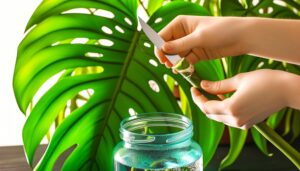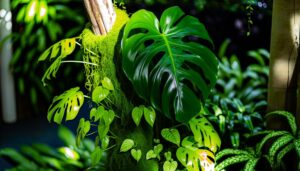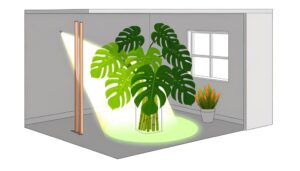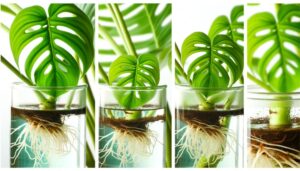Monstera Adansonii in Fish Tank
Incorporating Monstera Adansonii into your fish tank transforms it into a natural biofilter, absorbing nitrates and harmful compounds. This plant enhances water quality and boosts oxygen levels through its extensive root system and broad leaves.
Maintaining this environment requires stable pH, ideal temperatures, and nutrient-rich substrates. Choose fish like Neon Tetras or Corydoras Catfish that won't harm the delicate leaves.
Ensure proper lighting with full-spectrum LEDs and employ regular pruning to prevent overgrowth. Monitoring water parameters is essential to maintain a balanced ecosystem.
With the right conditions, you'll maximize the plant's full potential within your aquarium.
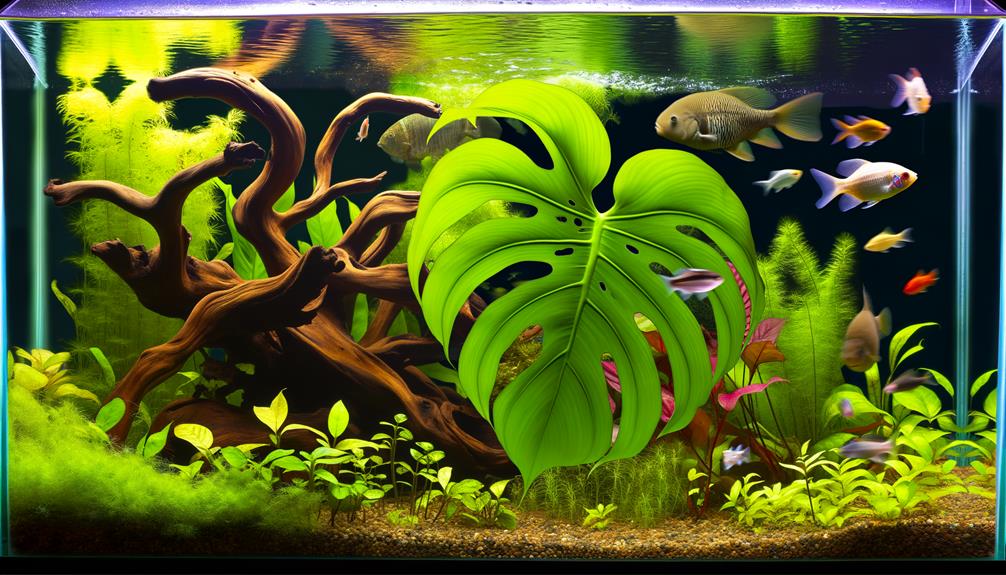
Key Takeaways
- Monstera Adansonii enhances water quality by absorbing nitrates and harmful compounds.
- Compatible fish species include Neon Tetras, Corydoras Catfish, and Otocinclus Catfish.
- Maintain a pH range of 6.0 to 7.5 and water hardness between 3-8 dGH.
- Use full-spectrum LED grow lights with a photoperiod of 10-12 hours daily.
- Regular maintenance includes trimming dead leaves and monitoring for pests.
Benefits of Monstera Adansonii
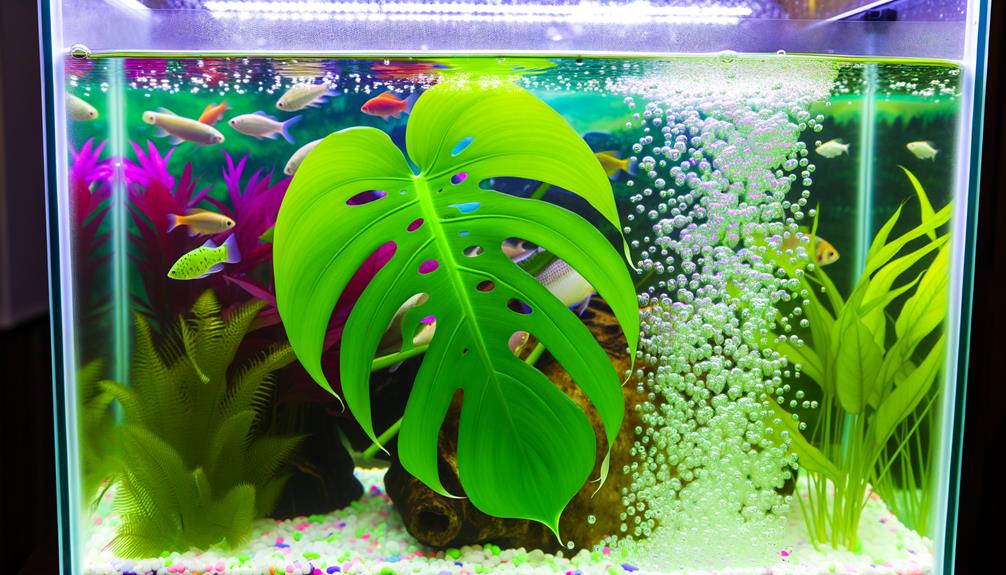
One of the primary benefits of incorporating Monstera Adansonii in a fish tank is its ability to enhance water quality by absorbing nitrates and other harmful compounds. This plant acts as a natural biofilter, utilizing its root system to uptake excess nutrients that can be detrimental to aquatic life.
By reducing nitrate levels, Monstera Adansonii helps maintain a balanced nitrogen cycle, preventing algal blooms and ensuring a healthier environment for your fish. Additionally, the plant's broad, fenestrated leaves increase oxygenation through photosynthesis, further stabilizing the tank's ecosystem.
You'll notice an improvement in water clarity and overall fish well-being. Integrating Monstera Adansonii into your aquarium setup isn't just aesthetic; it's a scientifically backed method to sustain ideal water conditions.
Plant Selection Tips
When selecting Monstera Adansonii for your fish tank, make sure you choose fish species that won't damage its delicate leaves, such as tetras or guppies.
Optimize the tank environment by maintaining water parameters within 22-28°C and a pH level of 5.5-7.5.
Providing adequate lighting and nutrient-rich substrates will support the plant's growth and overall health.
Compatible Fish Species
Choosing the right fish species for a tank with Monstera adansonii involves considering factors such as water parameters, fish behavior, and compatibility with the plant's environmental requirements.
It's essential to select species that thrive in similar pH, temperature, and hardness levels as Monstera adansonii. Additionally, fish shouldn't exhibit aggressive or fin-nipping behaviors that could damage the plant.
Here's a list of compatible fish species:
- Neon Tetras: Peaceful, small, and thrive in slightly acidic to neutral water.
- Corydoras Catfish: Bottom dwellers that help keep the substrate clean without disturbing the plant.
- Otocinclus Catfish: Algae eaters that maintain cleanliness without harming the foliage.
Tank Environment Needs
To create a top tank environment for Monstera adansonii, make sure that the plant receives sufficient light, maintains proper water quality, and is supported by a nutrient-rich substrate. Optimal light can be achieved using full-spectrum LED lights. Guarantee water parameters remain stable—pH between 6.0-7.5 and temperatures of 70-80°F. Nutrient-rich substrates, like organic potting soil, promote root development.
| Light Level (lux) | pH Range | Temperature (°F) |
|---|---|---|
| 10,000-20,000 | 6.0-7.5 | 70-80 |
| 20,000-30,000 | 6.5-7.0 | 72-78 |
| 30,000-40,000 | 6.8-7.2 | 74-76 |
| 40,000+ | 7.0-7.5 | 75-80 |
| 50,000+ | 6.0-7.5 | 70-80 |
Also, guarantee adequate water filtration to prevent stagnation. Regularly monitor these conditions for a thriving Monstera adansonii.
Preparing Your Fish Tank
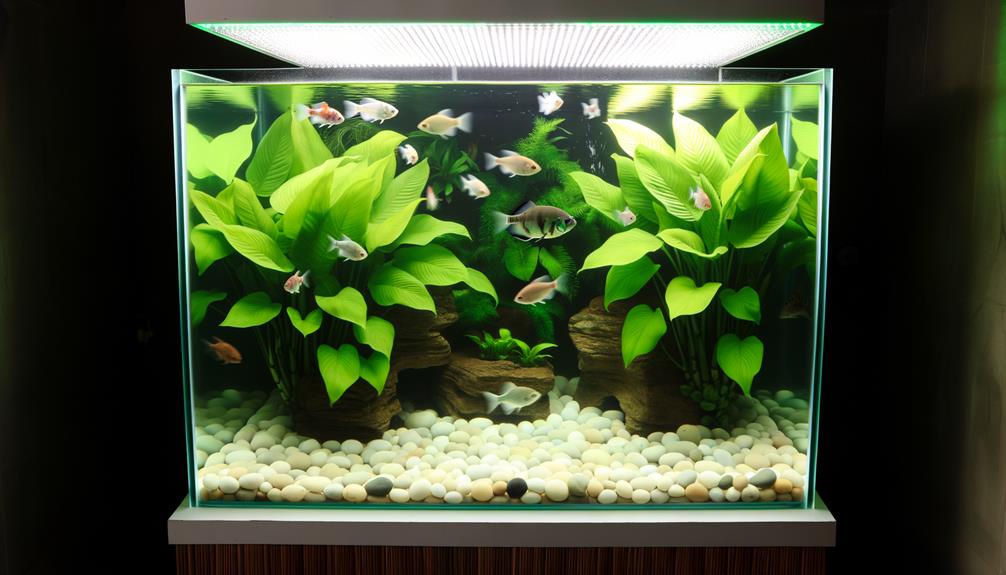
To prepare your fish tank for Monstera adansonii, start by ensuring thorough cleaning of all surfaces using aquarium-safe products to eliminate harmful residues.
Maintain ideal water conditions by monitoring pH levels between 6.0 and 7.5 and keeping the temperature within 75-85°F, ensuring a stable environment.
Install a reliable filtration system to maintain water clarity and reduce ammonia, nitrites, and nitrates.
Tank Cleaning Essentials
Start by gathering all necessary cleaning tools, such as a gravel vacuum, algae scrubber, and water conditioner, ensuring each is properly sanitized to maintain a healthy environment for your Monstera Adansonii and aquatic life. Regular tank cleaning is essential to prevent toxic ammonia and nitrite buildup, which can stress both plants and fish.
Essential cleaning tools include:
- Gravel vacuum: efficiently removes debris and uneaten food from the substrate.
- Algae scrubber: eradicates algae growth from tank walls, promoting clear water.
- Water conditioner: neutralizes chlorine and chloramine in tap water, making it safe for aquatic life.
Ensure you perform partial water changes biweekly, replacing 10-20% of the tank's volume to maintain ideal water quality and nutrient balance.
Ideal Water Conditions
Maintaining your fish tank to provide ideal water conditions involves preserving stable pH levels, temperature, and nutrient concentrations to support the health of both Monstera Adansonii and aquatic life.
Aim for a pH between 6.5 and 7.5, as significant fluctuations can stress both plants and fish. Sustain a temperature range of 70-80°F (21-27°C) to mimic the tropical environment.
Regularly test ammonia, nitrite, and nitrate levels; keep ammonia and nitrites at zero, and nitrates below 20 ppm. Use a high-quality water conditioner to neutralize chlorine and chloramine.
Introduce a gentle water flow to ensure oxygenation without disturbing plant roots. By carefully monitoring these parameters, you'll create an optimal environment for your Monstera Adansonii and aquatic species.
Water Parameters
Maintaining ideal water parameters is essential for the health of both Monstera adansonii and the aquatic life in your fish tank. You need to monitor and adjust several key parameters to create a thriving environment.
- Temperature: Keep the water temperature between 72°F and 82°F (22°C – 28°C) to support prime plant metabolism and fish activity.
- pH Level: Aim for a pH range of 6.0 to 7.5. This slightly acidic to neutral environment ensures nutrient availability for Monstera adansonii.
- Hardness: Maintain water hardness between 3-8 dGH (degrees of General Hardness). This balance helps stabilize both plant and fish health.
Regularly test these parameters using reliable aquarium test kits to guarantee a stable and healthy ecosystem.
Planting Techniques
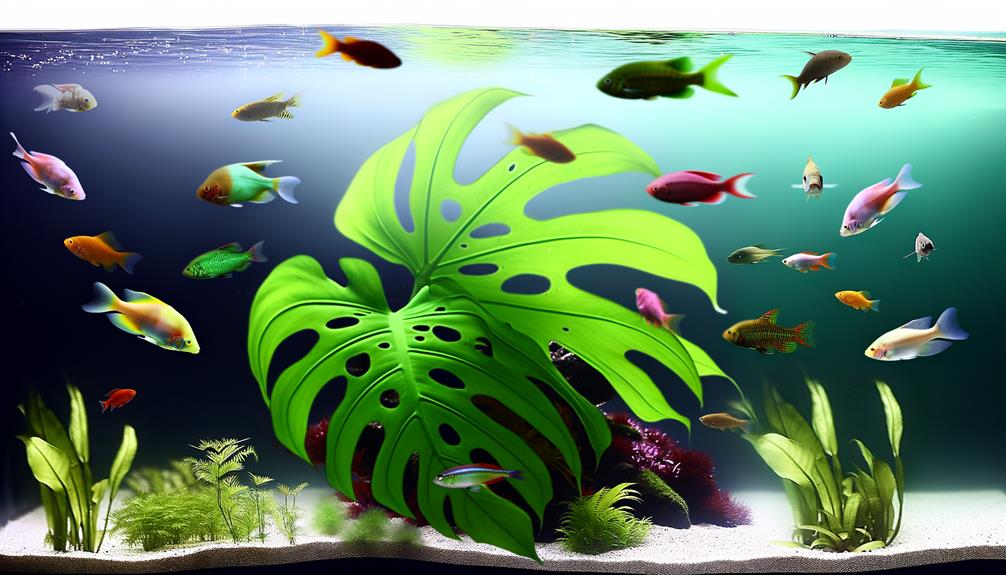
To effectively plant Monstera Adansonii in your fish tank, you'll need to think about appropriate substrate and rooting methods. Make sure the plant's roots have access to nutrient-rich substrates like aquatic soil or gravel mixed with organic matter.
Additionally, maintain ideal lighting and water conditions to support photosynthesis and overall plant health.
Substrate and Rooting Methods
Selecting the appropriate substrate and rooting method is crucial for successfully integrating Monstera Adansonii into a fish tank environment. The substrate should provide stability and adequate nutrients for best root development. Consider these options:
- Aquatic Soil: Rich in minerals, promotes root growth, and provides a stable base.
- Gravel: Allows for proper water flow and prevents root rot, but may need nutrient supplementation.
- Sand: Fine particles support delicate roots but can compact, leading to anaerobic conditions.
To root Monstera Adansonii, you can employ various techniques such as anchoring the plant to driftwood or rocks. Make sure that the plant's aerial roots are submerged to facilitate nutrient uptake and stability. This method mimics natural environments, promoting healthy growth.
Lighting and Water Conditions
Proper lighting and water conditions are essential for the ideal growth of Monstera Adansonii in a fish tank, guaranteeing the plant thrives in its distinctive aquatic environment.
You'll need to provide moderate, indirect light, mimicking its natural understory habitat. Consider using full-spectrum LED lights that simulate daylight, ensuring 10-12 hours of illumination daily.
Water parameters should be closely monitored: maintain a pH level between 5.5-7.5 and maintain temperatures ranging from 22-28°C (72-82°F). Regular water changes, approximately 25% weekly, prevent nutrient imbalances and promote peak health.
Utilize a gentle filtration system to avoid root disturbance. Monitoring nitrate levels, ideally below 20 ppm, is essential to prevent toxicity.
With these conditions, your Monstera Adansonii will flourish.
Light Requirements
Achieving Monstera adansonii receives sufficient light in a fish tank environment requires understanding its preference for indirect, filtered sunlight that mirrors its natural habitat under the forest canopy. You should aim for low to moderate light levels to prevent leaf burn and encourage healthy growth. Artificial lighting can be beneficial if natural light is inadequate.
- LED Grow Lights: Choose full-spectrum LED grow lights that offer a balanced light spectrum, crucial for photosynthesis.
- Light Duration: Maintain a photoperiod of 10-12 hours daily to replicate natural day-night cycles.
- Light Intensity: Avoid high-intensity lights which can lead to photoinhibition; instead, use lights with an intensity of 2000-3000 lux.
Proper light management ensures peak Monstera adansonii health in your aquatic setup.
Nutrient Needs
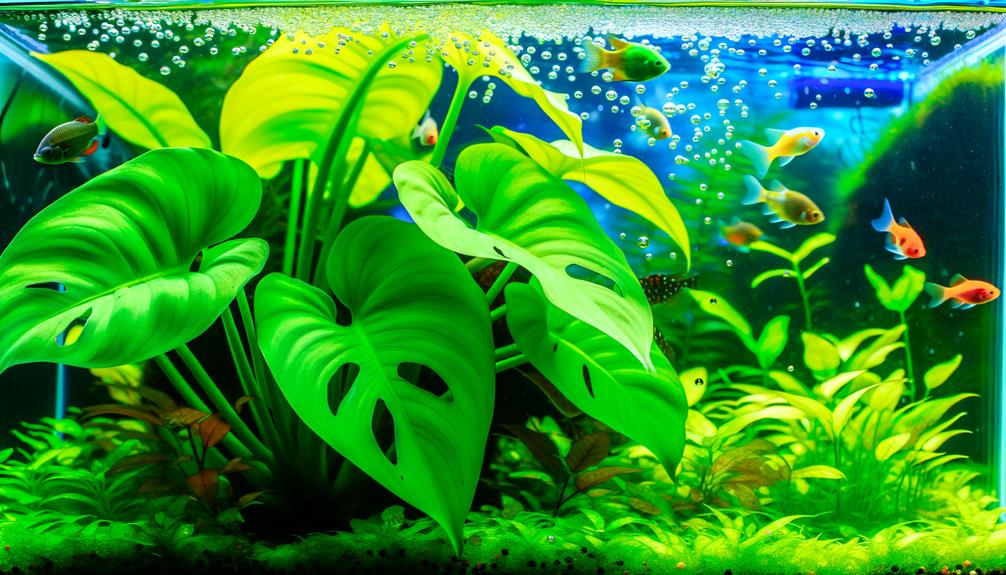
To flourish in a fish tank, Monstera adansonii requires a carefully balanced supply of essential nutrients, particularly nitrogen, phosphorus, and potassium, which support robust growth and vibrant foliage.
Nitrogen is necessary for protein synthesis and chlorophyll production, maintaining lush, green leaves. Phosphorus plays an important role in energy transfer via ATP, promoting root development and flowering. Potassium regulates stomatal function and osmotic balance, enhancing overall plant health.
Trace elements like iron, magnesium, and calcium are also essential; iron aids in chlorophyll formation, magnesium is a central component of chlorophyll molecules, and calcium stabilizes cell walls.
Utilize a high-quality aquatic plant fertilizer to guarantee these nutrients are consistently available, optimizing the Monstera adansonii's physiological processes and aesthetic appeal in your aquatic environment.
Maintenance and Pruning
Regular upkeep and strategic trimming are necessary for preventing Monstera adansonii's excessive growth and ensuring ideal light penetration and water circulation in your fish tank. To maintain optimal health, you must regularly inspect and trim the plant.
Use sterilized trimming shears to cut back overgrown vines, especially those obstructing light or flow. Trim dead or yellowing leaves promptly to prevent decay and nutrient depletion.
Inspect weekly: Check for excessive growth, yellowing leaves, and algae buildup.
Sterilize tools: Always use sterilized trimming shears to prevent disease transmission.
Moderate trimming: Trim no more than 25% of the plant at once to avoid shock.
Consistent and careful trimming will keep your Monstera adansonii healthy and your fish tank environment balanced.
Common Issues
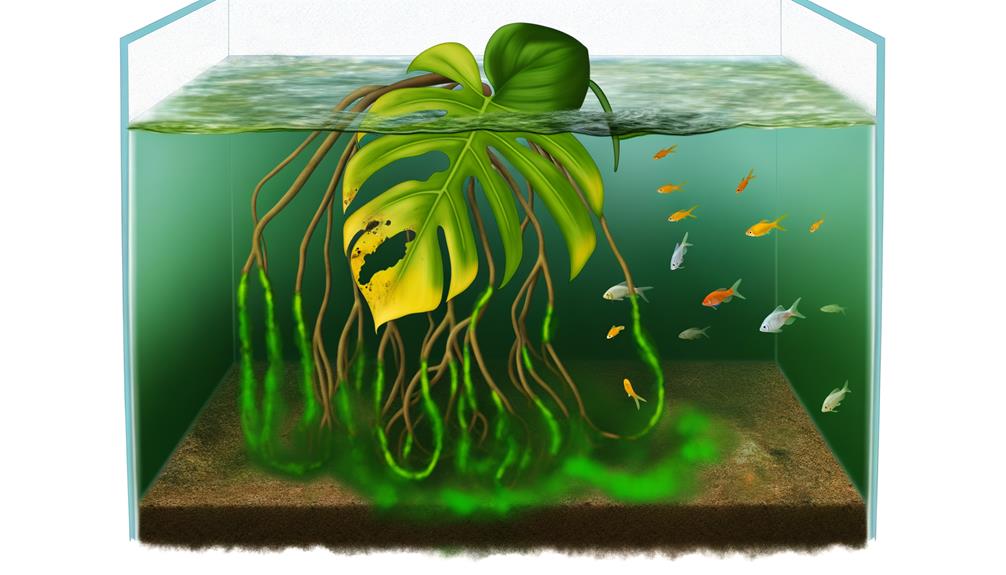
Over time, you might encounter common issues such as root decay, leaf color change, and pest invasions when keeping Monstera adansonii in a fish tank.
Root decay often results from anaerobic conditions in the substrate, so ensure proper aeration and avoid overwatering.
Leaf color change, particularly chlorosis, can indicate nutrient deficiencies or imbalanced pH levels; regular water testing and appropriate fertilization are vital.
Pest invasions like aphids or spider mites might occur due to high humidity and stagnant air. Introduce natural predators or use safe aquatic plant insecticides to manage them.
Regularly monitor the plant's health and promptly address these issues to maintain a thriving Monstera adansonii in your aquatic environment.
Fish Compatibility
When selecting fish species for a tank containing Monstera adansonii, it's important to take into account the plant's tolerance to varying water parameters and potential interactions with the tank's inhabitants. You'll need fish that won't uproot or nibble on the Monstera adansonii's delicate roots. Also, consider species that thrive in similar pH, temperature, and hardness levels.
- Neon Tetras: These small, peaceful fish won't disturb plant roots and prefer a pH of 6.5-7.5, which aligns well with Monstera's needs.
- Corydoras Catfish: Bottom dwellers that are gentle on plants and require similar water conditions.
- Otocinclus Catfish: Algae eaters that help keep the tank clean without harming your Monstera adansonii.
Choose species that complement the plant's habitat for best tank harmony.
Enhancing Aesthetics
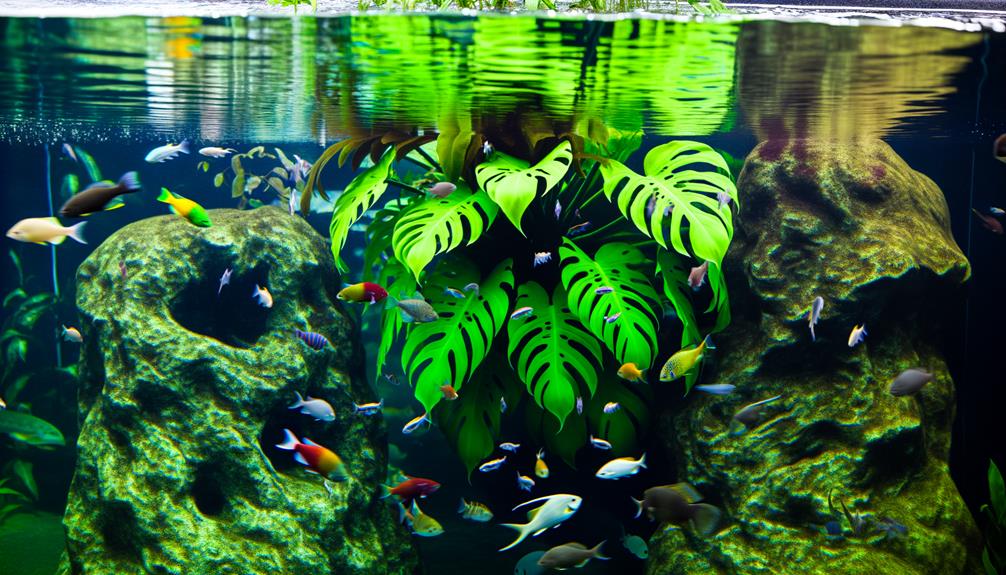
To enhance the aesthetics of your aquarium with Monstera adansonii, focus on strategic plant placement and complementary tank decorations that highlight the plant's unique fenestrated leaves. Position the Monstera near a background or mid-section area to create a lush, layered effect. Use driftwood and rocks to mimic a natural habitat, enhancing visual depth.
| Positioning | Impact |
|---|---|
| Near background | Luxuriant, layered appearance |
| Mid-section | Well-balanced visual appeal |
| By driftwood | Natural habitat emulation |
| Next to rocks | Heightened visual depth |
Integrate soft lighting to accentuate the plant's intricate patterns and provide a tranquil ambiance. Ensure water parameters, such as pH and hardness, complement both the Monstera and aquatic life to maintain an excellent environment. This approach will achieve a harmonious, visually striking aquarium setup.
Conclusion
Incorporating Monstera adansonii into your fish tank is like adding a breeze of fresh oxygen to an underwater ecosystem. You'll find that with proper water parameters, meticulous planting techniques, and diligent maintenance, this plant thrives while benefiting your aquatic life.
Addressing common issues and ensuring fish compatibility will create a harmonious environment. Ultimately, with your careful attention, Monstera adansonii won't only enhance the tank's aesthetics but also contribute to a balanced, thriving aquatic habitat.


